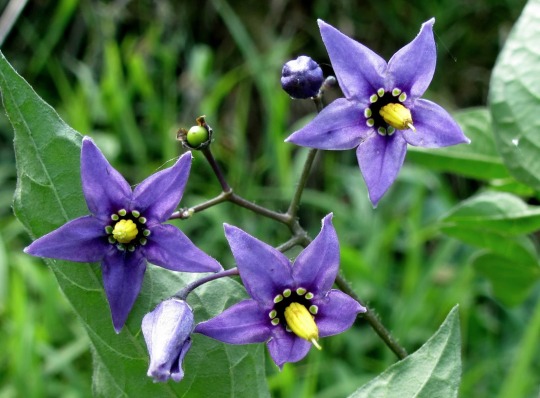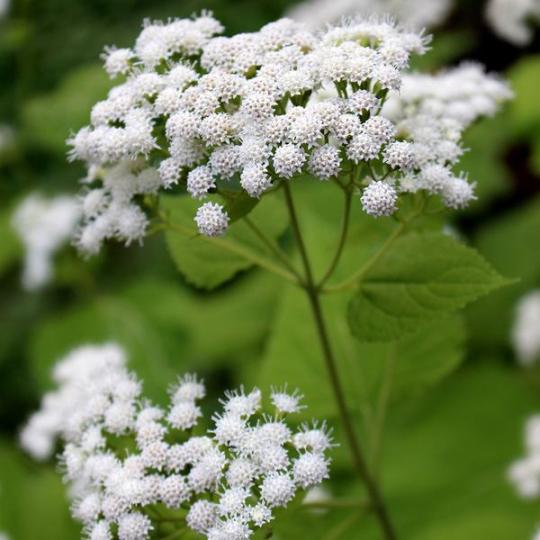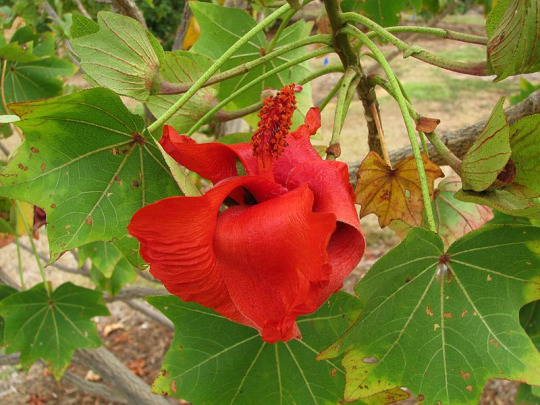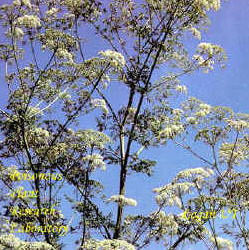Text
Botany
My botany class this semester was so insightful and fun! Some of my favorite things were the labs. I really enjoyed going out into this wooded area near our school and identifying trees and there fruits. It was also interesting to see some of the invasive trees such as the honey suckle. We also had a great professor that would brighten my day even though the class was so early. One of the best memories is being out in the woods and petting this squirrel that would climb all over me and my lab partner. I suggest everyone to take this class because you learn a lot and have lots of fun while learning.
0 notes
Text
Gimpy Gimpy

This is a harmless looking plant, but it is quite the opposite.
This plant has big green leaves and fruit with thorns that are too small to pick out with tweezers.
The Gympie gets the nick name of "suicide Plant" due to the amount of people who could not take the pain of the toxin so committed suicide.
Reports of people who have gone through this pain reports it's like being electrocuted and burned the entire time.
If you do not get the fragile fine thorns out, the pain could last for years before it goes away.
The hair like needles penetrate your skin releasing a toxin named moroidin.
https://curiosity.com/topics/the-gympie-gympie-tree-aka-suicide-plant-has-the-most-painful-stingers-in-the-world-curiosity/
https://i.ytimg.com/vi/6CuUMLkPey8/hqdefault.jpg
0 notes
Text
Nightshade

The deadly nightshade grows to a height of 1.5 meters and can be recognized by the dull, dark green leaves, and bell-shaped purple flowers. The sweet and juicy fruits make them tempting for children. Though it is found sparsely in the wild regions, it is limited to cultivation. It's one of the very few plants which are deadly for human beings but completely safe for animals and birds. The deadly poison attacks the nervous system, rendering the nerve endings in involuntary muscle paralysis. Symptoms include dilated pupils, sensitivity to light, blurred vision, headaches, confusion, and convulsions. As few as two ingested berries can kill a child, and 10 to 20 berries would kill an adult. Even handling the plant can cause irritation.
https://www.britannica.com/plant/nightshade
http://1.bp.blogspot.com/-7lFN_1ZI-dk/UhlNYty6OrI/AAAAAAAAXIo/qM-5AcPqffI/s1600/streampurpleflowers.jpg
0 notes
Text
Castor Oil Plant

Castor plant originated in Africa and is now found worldwide. It bears yellowish green flowers with a red center. The leaves are large with toothed edges. In ancient times, the castor bean was used in ointments, and allegedly, Cleopatra applied the oil to the whites of her eyes to brighten them. You must have heard about castor oil, a mild-tasting vegetable oil used as a food additive, flavoring in candy production, laxative, and to induce labor. It is derived from the plant seeds, which are 40-50% oil. This plant contains the deadly toxin: ricin. Ricin is found in high concentrations in the seed coating. Though seed poisonings are rare, there have been fatalities. Symptoms of castor poisoning include nausea, abdominal cramps, vomiting, internal bleeding, and kidney and circulation failure. Many people suffer from an allergic reaction to the dust from the seeds and may experience coughing, muscle aches, and difficulty breathing. Exposure to the dust is most common in areas where the beans are processed for commercial use.
https://www.amoils.com/health-blog/wp-content/uploads/2015/03/blog-image-castor-oil-plant-dollar-paid.jpg
http://castor-oil.com/castor-oil-plant/
https://www.newworldencyclopedia.org/entry/Castor_oil_plant
0 notes
Text
English Yew

These plants are believed to have played a part in pagan spiritual practices. Today, they are a symbol of the immortality of the soul. These giant trees stand as tall as 22 meters. All parts except the bark are poisonous. Consumption of the leaves, and to a lesser extent the seeds, can lead to increasingly serious symptoms, including dizziness, dry mouth, dilation of the pupils, weakness, irregular heart rhythm, and possibly death. The yew has been used for productive purposes as well. It served as a good material for making bows. It possesses medicinal qualities, such as a treatment of water elf disease. Studies show its enormous potential as an anti-tumor. Yew extract is used for Taxol, which slows the growth of numerous cancers. I really enjoyed learning about this plant. My major is pre-med, so I'm very interested in any medical history. If this plant could potentially change the world by helping with tumors, then it's something to research.
https://www.thompson-morgan.com/product_images/100/zoom/z-ENGL-T70312-A_h.jpg
https://www.bellarmine.edu/faculty/drobinson/EnglishYew.asp
0 notes
Text
White Snakeroot

The white snakeroot is a weed that grows in the shade in the eastern and southern parts of the united states. This plant contains high levels of tremetol, a very dangerous poison. This plant has been confirmed as the cause of death of Abraham Lincoln's mother. This plant causes a condition called milk sickness. Milk sickness is when a cow eats this plant and then we drink the cow’s milk. Some symptoms that humans get when consumed is bad breath, loss of appetite, listlessness, weakness, vague pains, muscle stiffness, vomiting, abdominal discomfort, constipation, coma, and death. My last four post have been over poisonous plants and I’m now obsessed with deadly plants. When I came across the Whit Snakeroot, I was intrigued. The plant has its history of killing Lincoln’s mother. Also, l live in eastern United States and its good to know potential dangers near me.
https://cdn.shopify.com/s/files/1/0739/9053/products/White-snakeroot_grande.jpg?v=1510830284
https://the-natural-web.org/2017/10/17/white-snakeroot-and-a-bit-of-a-paradox/
0 notes
Text
Aconite

Aconite is a beautiful plant but very deadly. The plant has blue, white, or flesh colored flowers. Though it’s a pretty flower, the whole plant is laced with poison that often people mistake it as horseradish or some other similar looking herbs. Contact with this plant can cause tingling, numbness, and in many cases, heart problems. Consumption of aconite can result in burning sensation, increased salvation, vomiting, diarrhea, changes in blood pressure, heartbeat irregulates, coma, and sometimes death. This plant has been used to lace bullets or darts to get an extra edge on the battlefield. I watched this tv show about a serial killer who would poison her victims with aconite. She never got caught because they would die due to a heart attack. I thought that it was so fascinating that a gorgeous plant could kill a human, so I investigated it.
https://www.naturalpedia.com/wp-content/uploads/sites/292/2017/08/Aconite-1.jpg
https://www.webmd.com/vitamins/ai/ingredientmono-609/aconite
0 notes
Text
Jimsonweed

Jimsonweed has the features of pointed fruits and leaves, giving it the scary feature that it deserves. This plant is common in the voodoo practices due to its hallucinogenic properties. With the right dosage of this plant it is known for medicinal properties such as relieving asthma symptoms, and as an analgesic during surgery. However, the reason why it's so dangerous is if you increase the dosage slightly it becomes fatally toxic. The slightest amount can cause serious health issue and even death. The plant is laced with the toxin's atropine, and scopolamine. I found this plant very interesting by how its helping one people and killing the next. My fiancé has bad asthma so I investigated how this plant might help. I changed my mind when I found out about the consequences being so much higher than relieving asthma symptoms.
http://cdn2.balconygardenweb.com/wp-content/uploads/2015/12/datura_mini.jpg
http://poisonousplants.ansci.cornell.edu/jimsonweed/jimsonweed.html
https://www.britannica.com/plant/jimsonweed
0 notes
Text
Machineel
Machineel gets its name due to the resemblance of its fruit and leaves like an apple. This fruit can be found throughout the ever glades of Florida, Central America, and the Caribbean. These apple-like trees are known for causing harm without direct contact with the tree. If you get the sap on your skin, it can cause damage such as rashes, skin irritation, coughing, loss of voice and so on. The sap is so strong that it removes car paint. If you inject the apple like fruit it can cause blisters in the mouth, swell the throat shut, and gastrointestinal problems. This tree is common around beaches. I am going to the Caribbean on my honeymoon and we are staying on the beach. I'm glad I found out about this dangerous tree. Getting all those symptoms will surely ruin an amazing week.
http://snaplant.com/wp-content/uploads/2015/08/manchineel-tree.jpg
https://www.ncbi.nlm.nih.gov/pmc/articles/PMC1127797/
https://adventure.howstuffworks.com/top-5-poisonous-plants1.htm

0 notes
Text
Kokia Cookei flower

https://en.wikipedia.org/wiki/Kokia_cookei#/media/File:Kokia_cookei_(4743890657).jpg -Photo URL
Kokia flower is a gorgeous red flower found in Hawaii in 1860. These flowers grow off trees that grow 3.5 to 4.5 meters tall. The Kokia is one of the most endangered flowers in the world with only 23 trees today. In 1960 their were only three trees.
This flower lives in dryland forest at 660 feet elevation. The threat to extinct the Kokia varies. Such as invasive plants, heavy grazing from animals like deer, goats, sheep, cattle, rats, lack of naturally rooted plants, and lack of viable seed production.
Since this is one of the rarest flowers in the world, precautions are to be made. Some of these precautions are monitoring the flowers from destructive bugs, fencing them to keep the grazing animals out, and try increasing the flower population.
When I hear the word endangered, I thought of animals and not plants. We are surrounded by so much vegetation that I though there was an abundance of everything everywhere. I was wrong because this beautiful flower has such a low count. One catastrophic event in Hawaii around these plants and they are just gone. A thing you’ll only see in the history books. I defiantly can see a time where these flowers will be extinct, but I certainly hope we can maintain there existence.
https://dlnr.hawaii.gov/wildlife/flies/2013/09/Fact-Sheet-Kokia-cookei.pdf
https://www.visitheusa.com/experience/5-flowers-youll-only-find-use
0 notes
Text
Hemlock

Conium maculate, poison hemlock, is a poisonous plant that grows throughout the united states. Hemlock is a very toxic plant to livestock, and very poisonous to humans. Poison hemlock starts growing in the spring. They look like a plant with a cluster of white flowers that can grow two to three feet tall. Poison hemlock is typically found in moist, and waste places such as ditches or fences.
I wrote about this plant because it is very common and not many people know or understand the dangers to this plant. I used to live on this farm in Indiana that had these long deep ditches that had enormous amount of poison hemlock. Me and my siblings use to love playing in those ditches and little did we know how dangerous it was. Luckily, we didn’t find the plant appealing and eat it.
Poison Hemlock is classified in the same family as carrots, parsnips, and dill, also known as the Apiaceae family. The roots of poison hemlock look identical to parsnips, and are commonly picked and consumed.
Signs of exposure to this poison is salvation, dilation of pupils, rapid or weak pulse, respiratory paralysis, and coma. If not treated it’ll result in death. If you see this deadly plant in your neighborhood be cautious and teach your kids so they know not to play around with that plant.
Remove this plant as soon as possible, and be sure to remove the roots a long with it. When disposing be careful if you dispose using fire. Poison hemlock, when burned, can go airborne and get in your lungs causing respiratory problems. Be sure to wear a mask and eye protection when burning. I often to just pull it and let it die then just throw it into the trash. Also if you have a lot of livestock be careful on what they eat because lots of consumption of this plant can lead to illness and then death with in 3 hours.
Source of photo
https://www.ars.usda.gov/pacific-west-area/logan-ut/poisonous-plant-research/docs/poison-hemlock-conium-maculatum/
Source of Information
https://www.poison.org/articles/can-poison-hemlock-be-deadly-184
1 note
·
View note